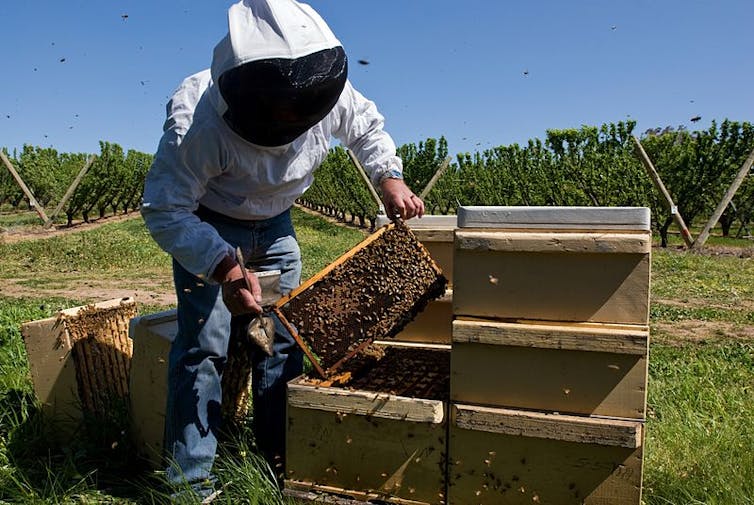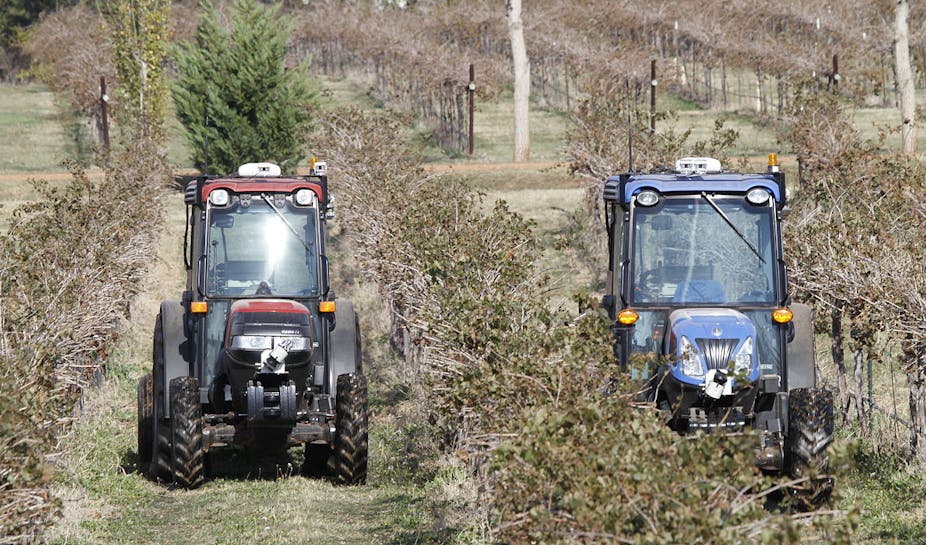Since World War II, Europe’s agricultural sector has been very receptive to new technology, and the result has been staggering productivity gains – for four generations, farmers have produced more than their parents did. At the same time, however, agricultural prices have fallen around the world and price subsidies have been cut. This has led to a cruel paradox: while farmers have never produced so much, many can no longer make a living from farming.
Digital technology is a big tent
Digital approaches in farming are called “precision agriculture”, which aims to measure the needs of crops or livestock as precisely as possible to be able to apply “the right amount at the right time”. This has proven to be a valuable approach, particularly for crops, and has been driven by the development of embedded computing, GPS guidance and machine control interfaces.
The precision-agriculture approach can also help reduce inefficiencies and waste. For example, precision pesticide application methods can significantly reduce spray falling outside areas to be treated and thus the amount of pesticide entering the environment. In this way, sprayers can maintain treatment effectiveness while reducing application rates 20% to 40%.
However, precision agriculture does not call into question pesticide use. It works by refining current practices and does not encourage the exploration of alternatives. This is what scientists call “technological lock-in”, with precision approaches reinforcing pesticide use rather than eliminating it. This in no way prepares us for farming that is less reliant on pesticides – farmers become locked in.
Like digital approaches developed in other industrial sectors, those for farming tend to impose standardisation and optimisation under well-controlled conditions. The risk, therefore, is that digital technology could increase productivity but also cut employment in the sector, boost farm size, and deepen technological dependence, with relatively little positive impact on sustainability.
A different type of digital agriculture
On the other hand, digital technology could also be used to empower those working together to improve farming practices, change regulations and influence markets, all built upon the real needs of individual farmers and society. By facilitating such cooperation at the national and multinational scale, digital technology would make it possible for farmers and the wider public to “have a say” in national farming issues. In bringing supply and demand closer together, collaborative digital farming would provide a framework for championing the interests of both producers and consumers, equitably.
In a context of increasing competition, this would protect rural employment, while assuring that agriculture is more widely valued, with farmers being seen as professionals. Existing cooperative approaches, such a local “box schemes”, contribute to this, but digital technology would accelerate and extend this process.
The potential of new digital technologies in agriculture is astonishing. Linking farmers digitally would allow them to organise and share equipment, facilitate the sharing or exchanging of fields and support alternative supply and production channels, as well as promoting solidarity. In short, collaborative digital technologies could promote aspects of social and environmental sustainability that the current form of the market neither recognises nor finances.
What technology should be used for
The current system will not change if we do not change the criteria we use for evaluating its performance and the way it is managed. We need to be clear as a society about what farming should do. To date, agriculture has been given goals that were not necessarily its own. Some have no direct market value, such as for the maintenance of common resources, including air and water. Others appear to have little immediate societal value, such as the storage of carbon to mitigate climate change, or do not reward farmers for their efforts. As an example, the value of lavender fields for tourism and for the industry of honey-making exceeds the direct income from selling the lavender for cosmetic use, and yet the lavender farmer will often receive no extra income for supporting these other industries.
It can be argued that the competitiveness of European agriculture will not be achieved by a race for productivity, but rather by doing those things we do well and value that bit better. We need to recognise that agriculture has become much more than a means to produce food, fibre and fuel. It is, just as importantly, a context in which questions of animal welfare and the management of the countryside landscape and resources need to be addressed.
The million-dollar question
The processes that take place in the agricultural environment are highly dynamic, changing over seasons and between landscapes, determined by the quality of an animal’s or plant’s interaction with its environment, and this itself evolves over time.
To monitor or change how agricultural systems function, digital technology should be used to evaluate material and energy flows. Just as an industrial system or supply chain must maintain and regulate its proper functioning, agriculture must be able to quantify what constitutes appropriate functioning. At present, we are unable to carry out the measurements needed to support, maintain or even improve the functioning of the agro-ecosystem. The future development of new sensors will revolutionise animal and plant health management.

It is possible to reduce this vision of digital technology to a simplistic level; that one sensor is used to measure a single variable, such as the weight of an animal. Our vision is that digital technology has the power to be transformative. Multiple sensors measuring multiple variables simultaneously could revolutionise the use of pesticides, for example, by quantifying the state of each field and the risk to human health that pesticides present. This might be by analysing sensor data with artificial intelligence to evaluate soil activity of both the pesticide and pesticide-detoxifying bacteria; estimating whether naturally present biological control agents have the capacity to protect the system from pests; and predicting when crop resistance to fungal pathogens is “switched on”. In effect, this would evaluate whether the system is resilient, being able to both to absorb shock and to rebound to a healthy state.
High performance, not just high production
The principle of pesticide-free agriculture must be at the heart of this future, digitally supported agricultural system. Simply characterising the performance of agriculture as one of a production system supported by pesticides will not deliver sustainability. Measures of system performance based on a single economic criterion do not reflect all the other dimensions of sustainability. Instead, digital technology must deliver a transition to a holistic appreciation of agriculture. It will allow us to appreciate aspects of the system that we know are critical but, due to poor measurement or recognition, we only notice once they are gone. Pollination by wild insects is an example of something farmers have, to date, received for free and so have undervalued. It is only now that we are discovering that these insects are in decline there are no longer enough to meet our needs.
Rather than locking in farmers to unsustainable, pesticide-based management, the agricultural digital revolution must show that there are other viable approaches and alternative measures of system performance. At a time when the European Union’s common agricultural policy and other global trade and agricultural agreements are being renegotiated, we must ensure that environmental sustainability and social justice – for both producers and consumers – are central to how performance is measured, and that they can’t just be sacrificed for a few more percentage points of productivity.


